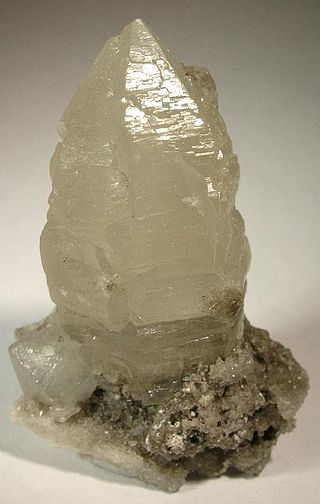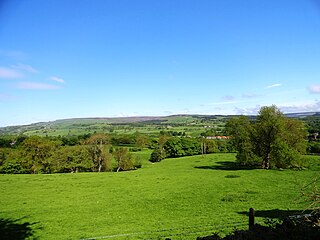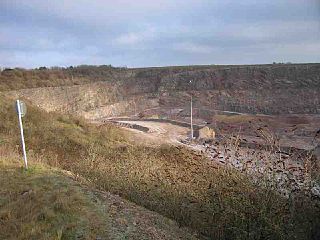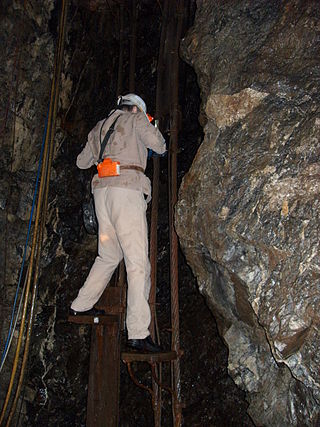
The Black Forest is a large forested mountain range in the state of Baden-Württemberg in southwest Germany, bounded by the Rhine Valley to the west and south and close to the borders with France and Switzerland. It is the source of the Danube and Neckar rivers.

Fluorite (also called fluorspar) is the mineral form of calcium fluoride, CaF2. It belongs to the halide minerals. It crystallizes in isometric cubic habit, although octahedral and more complex isometric forms are not uncommon.

Baryte, barite or barytes ( BARR-eyet, BAIR- or bə-RYTE-eez) is a mineral consisting of barium sulfate (BaSO4). Baryte is generally white or colorless, and is the main source of the element barium. The baryte group consists of baryte, celestine (strontium sulfate), anglesite (lead sulfate), and anhydrite (calcium sulfate). Baryte and celestine form a solid solution (Ba,Sr)SO4.

Witherite is a barium carbonate mineral, BaCO3, in the aragonite group. Witherite crystallizes in the orthorhombic system and virtually always is twinned. The mineral is colorless, milky-white, grey, pale-yellow, green, to pale-brown. The specific gravity is 4.3, which is high for a translucent mineral. It fluoresces light blue under both long- and short-wave UV light, and is phosphorescent under short-wave UV light.

Weardale is a dale, or valley, on the east side of the Pennines in County Durham, England. Large parts of Weardale fall within the North Pennines Area of Outstanding Natural Beauty (AONB) – the second-largest AONB in England and Wales. The upper dale is surrounded by high fells and heather grouse moors. The River Wear flows through Weardale before reaching Bishop Auckland and then Durham, meeting the sea at Sunderland.
The Mining Association of the United Kingdom is a trade association for all kinds of mining undertaken by UK companies.

Colemans Quarry, grid reference ST726452 is a limestone quarry at Holwell, near Nunney on the Mendip Hills, Somerset, England.

Tajikistan has rich deposits of gold, silver, and antimony. The largest silver deposits are in Sughd Province, where Tajikistan's largest gold mining operation is also located. Russia's Norilsk nickel company has explored a large new silver deposit at Bolshoy Kanimansur. More than 400 mineral deposits of some 70 different minerals have been discovered in Tajikistan, including strontium, tungsten, molybdenum, bismuth, salt, lead, zinc, fluorspar, and mercury. These minerals have been found suitable for mining. Uranium, an important mineral in the Soviet era, remains in some quantity but is no longer being extracted. The Tajikistan Aluminium Company (TALCO), an aluminium smelter, is the country's only large-scale production enterprise in the mining sector. Tajikistan hosts the annual Mining World Tajikistan, an international exhibition on mining in Dushanbe.
The Kenya Fluorspar Company is a mining company in Kenya, located in Kimwarer, a village in the southern part of the Kerio Valley in Elgeyo-Marakwet County, that was among the few large-scale mining and metallurgical operations in Kenya, and ranked among the country’s leading foreign exchange earners. It operated as a state corporation between 1971 and 1997 and as a private company between 1997 and 2018.

The Samson Pit or Samson Mine is an historic silver mine in Sankt Andreasberg in the Upper Harz region of central Germany.

The Ljubija mine is a large open pit mine located in Prijedor, in the western part of Bosnia and Herzegovina in Republika Srpska, 48 km South - East of Banja Luka and 250 km South - East of the capital, Sarajevo. Ljubija represents the largest iron ore reserves in Bosnia and Herzegovina having estimated reserves of 442 million tonnes of ore. The mine produces around 2,900,000 tonnes of iron ore/year. Iron ore is mined together with zinc, lead, baryte and fluorite.

The Glasebach Pit is a mining museum and former pit in the Harz fluorspar mining area near Straßberg in the German state of Saxony-Anhalt. It is run by the East Harz Mining Society. The pit was founded under the name of Vertrau auf Gott.

Sulzbächle is a small river of Baden-Württemberg, Germany. It flows into the Kinzig west of Schiltach.

Rampgill mine is a disused lead mine at Nenthead, Alston Moor, Cumbria, England UK Grid Reference: NY78184351

The Silberberg, at 1,358.2 m above sea level (NHN), is the most prominent summit in the mountain group around the Herzogenhorn in the Black Forest in the southwest German state of Baden-Württemberg. It lies about 4 kilometres east of the town of Todtnau.

The Finstergrund Pit near Wieden in the Black Forest in Germany is an abandoned medieval silver and lead mine that was also used in the modern era to extract fluorite and baryte. Since 1982 it has been used as a visitor mine.

MiMa is a museum of mineralogy and mathematics in Oberwolfach, in the central Black Forest in southern Germany. The museum was opened on 30 January 2010 on the site of the mineral museum after a two-year conversion and expansion phase. It is operated jointly by the municipality of Oberwolfach, the Oberwolfach Society of the Friends of Minerals and Mining and the Mathematics Research Institute, Oberwolfach.

The Wenzel Pit is a former silver mine in the Zinken Frohnbach in Oberwolfach in the Black Forest in southern Germany. The pit had its heyday in the Napoleonic era, but has been a show mine since 2001.
Forrestania Operation is an underground nickel mine at Forrestania, 80 kilometres (50 mi) east-southeast of Hyden, in the Shire of Kondinin, Western Australia.

Black Swan Nickel Mine is an inactive surface and underground nickel mine near Kanowna, Western Australia.


















